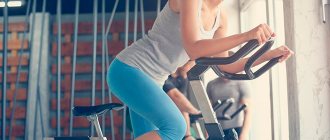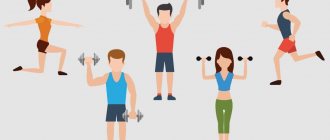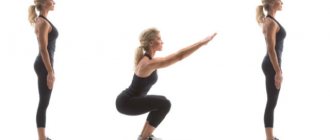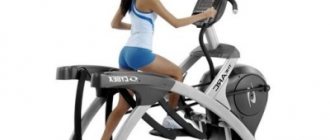You will burn:
Fat equivalent:
Any person suffering from excess weight has made attempts to lose it more than once. Some exhaust themselves with endless diets, others with sports activities, and some keep the most accurate calorie count, in which a step to the right and a step to the left means execution. What is a calorie? Everyone has heard this word more than once, but not everyone can explain: “what is it?” In simple terms, a calorie is a unit of measurement for the production of heat by our body. Every day we eat food that gives us energy. So, a calorie is a convenient option for counting it. In order to create an individual weight loss program, you need to know how many calories you get per day. The golden rule: “Burn more calories than you consume!”
How many calories are burned when running on a treadmill?
In addition to taking into account the caloric content of dishes, physical activity is also needed. To carry out different types of activities, different amounts of energy are spent:
- mental work – 1500-200 kcal;
- physical work -2000-2500 kcal;
- active physical work – 2500-3500 kcal;
- sports training – 3000-3500.
1500-2500 kcal is considered optimal for humans. In this case, you need to consider what products will be consumed. A great option for burning calories is the treadmill. Many modern exercise machines are equipped with various sensors, including ones that display the amount of Kcal. But it is worth remembering that on such devices the accounting is averaged and, as a rule, shows inflated values. Nevertheless, for some this serves as an additional incentive: “What a great guy I am, I worked out and lost so many calories!”
For a more accurate calculation, you need to know at least the weight, distance and time spent on the activity. Therefore, it is very difficult to give an exact figure that you will need. You need to independently calculate the number of calories based on your parameters. For ease of calculation, you can use a special calculator. When jogging on a sports machine, you can spend from 500 to 750 calories per hour. These indicators are also averaged, since they are influenced by the intensity of the load, intervals, and heart rate per minute.
What is a calorie?
A calorie is the amount of heat energy required to heat 1 gram of water by 1 degree Celsius. It is known that 1 cal = 4.1868 J. Initially, calorimeters were used to measure heat.
The father of dietetics can easily be called the American agricultural chemist Wilbur Olin Atwater, who was the first to learn how to calculate the caloric content and energy content of food.
By experiment, the well-known calorie values of the three main components of food were obtained: carbohydrates 3.75 kcal/g, proteins 4 kcal/g, fats 9 kcal/g.
Oddly enough, alcohol-containing drinks are also high-calorie foods (7 kcal/g), but one should not draw hasty conclusions. The human body independently produces ethanol in an amount of 0.002%. This alcohol is involved in oxidative reactions and is necessary for the processing of nutrients.
In the case of regular intake of alcohol from the outside, the amount of internal endogenous alcohol is significantly reduced, causing a strong physical need for alcoholic beverages to maintain the required concentration of ethanol in the blood. Moreover, alcohol is a highly toxic substance for all organs, causing rapid addiction, dependence and tissue destruction. The liver, cerebrospinal fluid and brain are especially affected.
How many calories are burned when walking on a treadmill?
If you seriously decide to lose weight, then in addition to drawing up a menu according to all the canons of weight loss programs, you also need sports activities. You should start exercising on a treadmill by walking. You may not have tremendous results in weight loss, but this way you will gradually increase physical activity without harming your health. And soon the indicators of kilocalories spent will also rush to please you. When walking, calorie consumption is:
- calm walking – 354-450 kcal;
- walking at an incline – 450-550 kcal.
All this data is conditional. You need to take into account your heart rate during exercise and the duration of your walk. The basic rule for obtaining a weight loss effect is to last at least 40 minutes. Only after this time has passed does fat burning begin.
Mifflin-St. George formula for calculating calories
This formula gained popularity in the mid-2000s and has since been relevant for accurately calculating the number of calories burned.
For women: Kcal = VOOM * k For men: Kcal = BOOM * k, where k is the load coefficient, depends on the nature of physical activity (see Table 3)
Table 3 - Calculation of coefficient k for the Mifflin-San Geor formula.
| Character of loading: | k |
| Minimum load (sedentary work) | 1.2 |
| Some daily activity and light exercise 1-3 times a week | 1,375 |
| Workout 4-5 times a week (or moderate work) | 1.4625 |
| Intense training 4-5 times a week | 1.550 |
| Daily workouts | 1.6375 |
| Daily intense workouts or workouts 2 times a day | 1.725 |
| Heavy physical work or intense training 2 times a day | 1.9 |
The basal metabolic rate is calculated using the formulas:
BOOM = 9.99 * weight (kg) + 6.25 * height (cm) – 4.92 * age – 161 BOOM = 9.99 * weight (kg) + 6.25 * height (cm) – 4.92 * age + 5
How many calories are burned on a treadmill in an hour?
Calorie burning rates are very average. This is influenced by several factors:
- weight and age;
- speed;
- time;
- training intensity;
- level of physical fitness.
An overweight person will initially find it very difficult to walk or run for long periods of time. Everything should happen gradually, but most importantly regularly. You shouldn’t neglect your training and you should definitely exercise once every one or two days. At first, your muscles will ache; this is normal; your body gets used to physical activity.
An hour on the treadmill helps you spend:
- running – up to 750 kcal;
- walking – up to 450 kcal;
- walking at an incline – up to 550 kcal;
- running uphill - up to 650 kcal;
- interval training – up to 850 kcal.
These figures are approximate. To obtain this effect, you must maintain a pulse of 120-140 beats per minute. It is in this interval that effective fat burning begins. It is important to remember that in order to lose weight, you need to burn more calories than you consume, but not too many. Otherwise, the body will accept such a signal as starvation, and vice versa, it will begin to effectively store it in adipose tissue.
Interval running
Interval running combines short bursts of high-intensity exercise with short recovery periods of low-intensity exercise. An interval running workout can consist of an intense sprint for 1 minute followed by a 2-minute walk. A full session typically consists of a 5-minute warm-up, 10-12 intervals of varying lengths, and a 5-minute cool-down period at the end. Using lifts and resistance can also be considered interval training.
How many calories are burned on a treadmill in 15 minutes?
The length of your workouts depends on your fitness and goals. Running on a sports machine for 15 minutes at an average speed, a person of average build and weighing no more than 60 kg will lose about 150 kcal. At the initial stage, it is enough to exercise for 15 minutes so that the body has time to get used to the stress. Gradually you need to increase the time and intensity of training.
To achieve the greatest weight loss effect from exercising on a treadmill, it is important to know:
- The maximum effect can be obtained with interval or jerky running. First, find a running pace that is comfortable for you. Then after a certain period you need to speed up for a short period of time. Throughout the entire distance, you need to repeat such accelerations and return to your usual pace;
- The heart rate should be 120-140 beats per minute. It is in such an intense interval that fat burning begins;
- duration of classes. The effect of walking on a treadmill will appear only after 40 minutes, when running after 20. Therefore, long-term training is very important;
- Regularity. You shouldn’t give up on classes if you think they are of no use. Not true. The most important thing is that walking or running is so that they become an integral part of your life and you can always exercise at least once every 2 days.
Energy consumption of different processes of physical activity
Muscular activity significantly increases the body's energy expenditure. The more intense muscle work is performed, the more calories are consumed. If physical activity is associated with emotional experiences (sports games, competitions, martial arts), then much more energy is expended. Table 2 - Energy consumption for different physical activities.
| Exercise stress: | Consumption, kcal/hour |
| Food | 30 |
| Sedentary work | 75 |
| Sex | 100-150 |
| Walking (4 km/h) | 130 |
| Gymnastic exercises | 150 |
| Cycling (9 km/h) | 185 |
| Canoeing (4 km/h) | 190 |
| Swimming (0.4 km/h) | 210 |
| Walking (6 km/h) | 215 |
| Low intensity aerobic dancing | 215 |
| Modern dance | 240 |
| Horse riding | 255 |
| Downhill skiing | 270 |
| Ballroom dancing | 275 |
| Cycling (15 km/h) | 320 |
| Basketball | 380 |
| Dancing to the disco rhythm | 400 |
| Race walking | 416 |
| Swimming (2.4 km/h) | 460 |
| High intensity aerobic dancing | 485 |
| Running (11 km/h) | 485 |
| Skiing | 485 |
| Strength training on machines | 520 |
| Cycling (20 km/h) | 540 |
| Running up and down the steps | 540 |
| Jumping rope | 540 |
| Swimming fast crawl | 570 |
| Cross country running | 600 |
| Ballet classes | 750 |
| Running (16 km/h) | 750 |
| Running up the steps | 900 |
How to walk correctly: equipment and technique
Walking will only benefit you if you walk correctly. You should start with your clothes: they should be loose, comfortable and contain natural fibers. Heat loss during a walk is quite intense, so clothes must breathe. However, you should not get carried away so as not to catch heatstroke. Shoes for walking are designed using different principles than for running. In running shoes, cushioning is important, while in walking, the anatomical insole and sole material are important; it is advisable to purchase a pair with perforated inserts for “breathing”. A powerful platform with special elements, like for running, is not required here.
If you plan to walk with weights, you can purchase special accessories that are fixed on the hand or lower leg, or simply small dumbbells. Hands sweat intensely during training, so you should consider short, fingerless gloves.
For Nordic walking you will need special poles, which can be found in specialized sports stores. It also makes sense to take a small bottle of water and a towel with you. The benefits of these little things will become noticeable after half an hour of training and will allow you to extend it to the required minimum.
Indications for walking
Walking to lose weight may not just be a conscious choice, but a necessity. This sport is a good alternative to running when it is not possible to engage in such exercise. Walking is preferable if:
- diseases of the musculoskeletal system;
- during pregnancy;
- during the period of rehabilitation after injuries, acute conditions;
- in patients with cardiological and pulmonological profiles;
- in the elderly;
- in weakened people with low body weight;
- for pathologies of nervous tissue;
- for obesity.
The last point raises a particularly big question: it would seem that you should run to lose excess weight. However, with such a load of excess weight on the spine, joints, and heart, the body may not be able to withstand it.
Running is an undesirable start to weight loss in patients with second and third degrees of obesity.
The benefits of walking
What other benefits does walking have for losing weight? In addition to the obvious simplicity and guarantee of the correct load, the walk:
- strengthens the heart muscle: the muscles are loaded evenly, and the heart works in a constant cyclic mode;
- reduces the subjective feeling of fatigue;
- smoothes the shock load on the joints (unlike running, which can lead to injury);
- indicated for people with restrictions on other aerobic exercise, as well as during the rehabilitation period;
- a constant long period of load can be maintained;
- causes the release of endorphins, which improves mood and commitment to exercise.
The correct walking technique will allow you to work out the main muscle groups, as well as lose pounds without harm, and even with health benefits.
This type of load does not cause such a massive release of stress hormones (cortisol, adrenaline) in the body, which means it acts more gently and carefully in relation to the internal organs.
Ways to speed up calorie burning
There are many methods that can significantly increase calorie burning. Many of them do not bring any visible results. One of these is wrapping the body with film. Along with physical exercise, this method is visually very effective, but many skeptics believe that a person loses the fluid secreted by the body to cool the wrapped body surface. Therefore, the result is short-term and the weight gradually returns to its previous limits.
Only proper nutrition, regular exercise, good rest and sleep, and psychological work on oneself give tangible results.
With a sloped surface
The slope of the surface puts more stress on the legs. Muscles work harder, calories are burned faster. Therefore, walking with an incline leads to rapid weight loss. It also strengthens the leg muscles, since lifting them up requires significant tension. For beginner athletes, this is not the best option, since the unusual load may be excessive and lead to undesirable consequences.
And for people with diseases of peripheral joints (knees, ankles) it is better to completely abandon walking with an incline.











